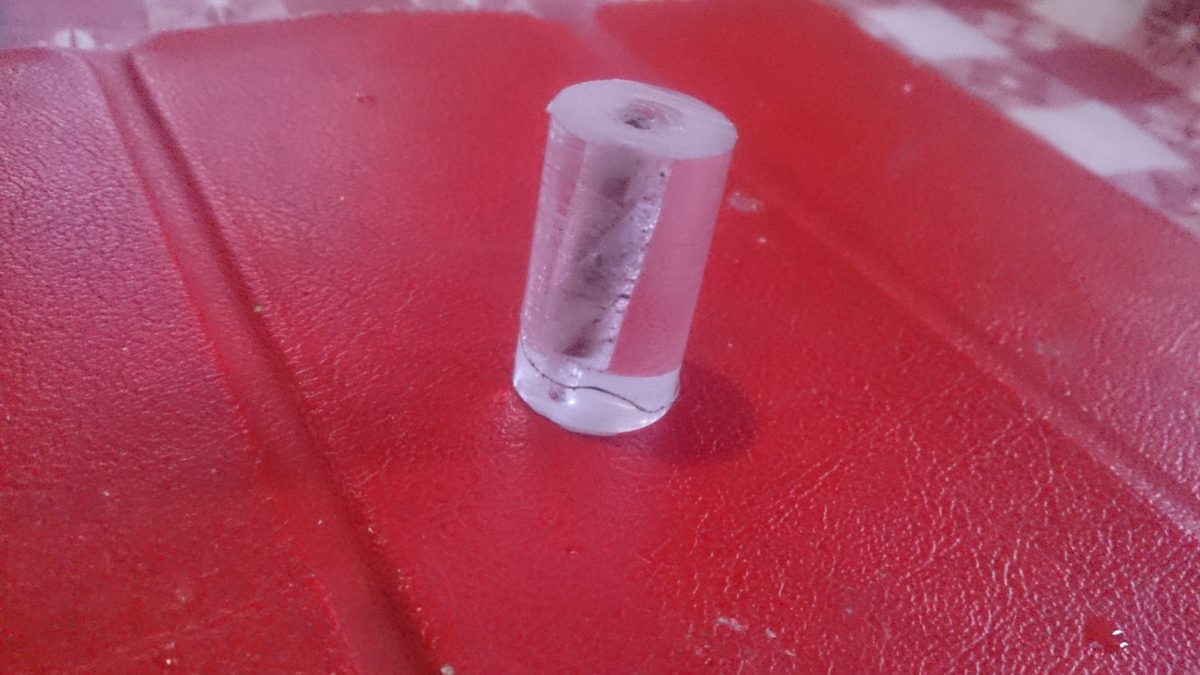Feb 1, 2018, Port Townsend, WA – January was the longest month I remember in my entire life. Longer than months when I was a small child slogging through the school year waiting for summer vacation.
It was a month of unexpected travel, traversing the country and working on non-boat projects. It was also a month full of activities and friends: an unexpected sailor on his way to pickup replacement boat parts and a medieval music performance in a Victorian church in a Victorian Seaport.
We got back to Seattle from Christmas on December 27th and lived on board until we found ourselves heading back to Atlanta for unexpected business on the seventh of January and then, once again, back to Seattle eight days later, on the fifteenth.
 I mistakingly shook hands with our Über driver on the fifteenth and by the end of the day on the sixteenth was sick as hell with a cold. I spent a few days doing nothing but sleeping; as I recovered Jennifer came down with it. This took us to the twenty-first when the Port Townsend house became available. We moved here on the twenty-second.
I mistakingly shook hands with our Über driver on the fifteenth and by the end of the day on the sixteenth was sick as hell with a cold. I spent a few days doing nothing but sleeping; as I recovered Jennifer came down with it. This took us to the twenty-first when the Port Townsend house became available. We moved here on the twenty-second.
On the twenty-sixth, we were back in Seattle for the boat show, returning to Port Townsend on the twenty-seventh, picking up Jennifer’s daughter Flora on the way here.
We learned Sam’s Club has apparently left Washington State* when we tired to shop at the now closed Kent store, which is a problem. We generally provision our boat out of Sam’s and Winco. I suppose we’ll move over to Costco, though having shopped professionally at both, I actively dislike Costco. Sam’s is/was designed for commercial accounts, while Costco is designed to make consumers hunt for products and engage in impulse shopping.
However, I’m finally back to the boat related tasks.
I returned to the boat this past Monday, catching the 6 o’clock bus from Port Townsend and arriving at the boat by 9 AM. I pulled out the starter and the Webasto heater.
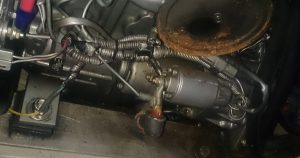
The starter was quite straightforward, though when I turned off the master switch that controls the starter battery, there was still 4 V between the starter high amperage lead and the battery ground. I’m thinking this is because there is leakage across the splitter that allows the alternator to charge the two strings of batteries. My friend Erwin is the one speak to about this.
The wiring is still not right: I had thought I had pulled the old fuse box off of the charging battery and moved it to the house batteries, but when I turned off the master switch everything connected to the old fuse box is still turned off… With the 4 V leakage. Or does the master switch turn off the ground?
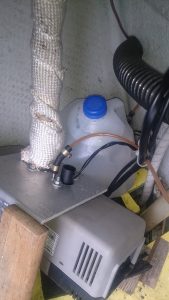
Removing the Webasto heater took a while, but it wasn’t quite the nightmare I expected.
During our 2016 trip to Alaska the mount for the Webasto heater, which was made from an old kitchen cutting board (not by me), deconstructed itself when the glue joints failed, dropping the heater into the cockpit locker. The mount I put together using some StarBoard was easy to unmount, and will be easy to remount. The problem was I hadn’t remembered how I had done it. And, of course, rather than completely emptying the locker to make myself as much space as possible, I emptied the locker slowly as I iteratively found I needed more space.
It also looks like I have misplaced one of my square drive screwdrivers – it wasn’t needed for this task, but it will be needed soon. I last used it when I was remounting the AIS transceiver (incorrectly referred to as a transponder) and the antenna splitter.
I caught the 3 PM ferry over to Bainbridge and was in the park-and-ride at Port Townsend by 6 PM. Along the way I spoke to Colin at Townsend Electric who told me he was quite certain the problem with the starter was not the starter at all, but the gauge and length of the wire from the starter button to the starter itself.
The wire is fourteen or 16gauge; it’s fairly small. However, Colin told me that until the starter is engaged the induction coil is drawing 40 A! The next morning Jennifer and I went over to meet Colin, who is a typical Port Townsender. He’s a brit from the Midlands, who came here as a Boeing engineer. After Boeing, he fished for salmon in Southeast Alaska, and then eventually ended up with this business.
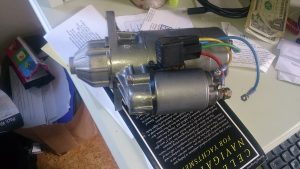
While Jennifer and I were in Colin’s shop, he measured the draw of the induction coil and found it was 60 A! This is an awful lot of power to push through 10 feet of 16gauge wire, even if it is only for few seconds. Colin agreed he’d pull apart the starter to make sure there were no problems with the armature, as I had suspected. He called about an hour later telling us the armature was fine and that he attached a relay that would pull the 12 V for the induction coil from the 12 V high amperage stud on the starter.
By the time Tuesday evening was over, I found I didn’t want to go back to Seattle again the next morning. This is interesting on its own for two reasons: it meant I was delaying working on the boat – though in fact there are plenty of boat-related things that need to be done online, and lots of non-boat related work that must be done in order to keep our income flowing.
When I was first out of college I commuted the same 2-½ hours each way from Long Island to Manhattan, every day and met people who had done that commute for thirty years.
By Tuesday night, Jennifer was feeling ill, and I had identified major documents I needed to write.
That takes us to Wednesday and through to today, Thursday.
However, sitting here writing this I realize that I was not unproductive during that week that I was sick aboard the boat.
And during our small time in late December and early January, though we planned to be completely idle in terms of working on the boat, it is not possible.
Among my accomplishments was destroying a 3/16 of an inch drill our marina mate Jeff Storm lent me to drill holes in a plexiglass rod for spacers for the plexiglass drop boards for the main cabin hatch.
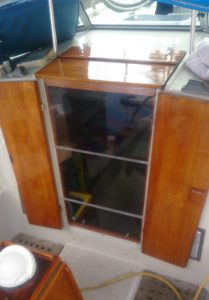
I cut these drop boards from half-inch Plexiglas I bought from Charlie at the plastic shop in Fremont. The design is such that I can keep the teak doors that are standard on the Maxi, and also have transparent drop boards, which let in light and have the strength advantages of drop boards.
With very sharp tools, plexiglass cuts almost like wood. The tablesaw and a router fling chips. A very sharp drill will remove turnings that look like transparent metal. A not-so-sharp drill melts the plexiglass as it proceeds through. Make the mistake of turning off the drill that is melting the plexiglass and the bit becomes embedded in the now hardened plastic. Either the entire bit stays in the plastic forever, or only the part embedded in the plastic remains after the drill bit is broken off. I chose the latter.
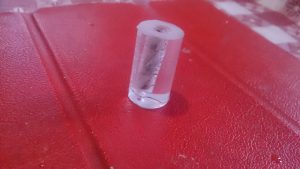
It has been very pleasant to see Caro Babbo on AIS day in and day out across the months. It is reassuring to know that she’s there and that the AIS is working.
On the to do list we brought to the boat was an item to update the firmware on the AIS. Although Vesper never lists bug fixes on their firmware updates, I have personally found bugs that were repaired from one rev to another. As someone who used to do software support, I also know that no support is to be had when running out of date software.
The shock, however, was that, although the AIS was transmitting, it would not speak via Wi-Fi or a USB hardwire connection. We discovered this in late December and discussed it with Vesper while we were in Atlanta in early January.
To my surprise, we were immediately given credence, which in some ways is a bad thing because it means they’ve seen the problem before. It’s also a good thing because it means the problem can be solved.
The answer was to reflash the firmware: a somewhat drastic and potentially frightening operation. Of course, one learns about hidden features along the way. In the bundle of wires that leads from the AIS to power, and along which the AIS speaks NMEA 0183, is a pretty-in-pink 22gauge wire. Ground that wire and, presto change oh, the device will suddenly start speaking over the USB connection in some previously hidden mode.
With the device in this previously hidden mode, the AIS management software running on my Mac suddenly seems to have a new feature and is quite eager to replace the firmware on the AIS. The process is completely automated and takes about forty minutes. During the process, the AIS device switches from speaking over the USB port to speaking over Wi-Fi, and then continues along its merry way. When it reboots, not only does everything work but it remembers all of its settings.
However, the firmware that the device has been flashed with is not the latest revision of the firmware, which I then upgraded to.
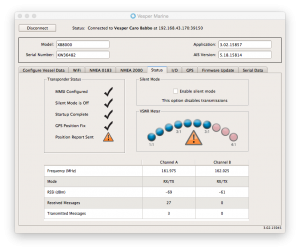
The only fun thing to notice was that a software gauge that was a progression of dots moving from blue to pink has been replaced by a more binary message that says whether the SVRS is above or below 3.1. Above 3.1 the reflection in the cable is too high and your transmission may not be going out.
There still seem to be some flaky things going on that I think are related to this particular unit. But I’ll try to hash that out in early March.
Keeping a to do list on a boat, and not deleting the accomplished tasks, is a good way of understanding how productive one is even when one feels that he hasn’t accomplished anything at all.
During that unproductive week, while Jennifer and I were sick, I fixed the leaking water bladder, I bought new shoes to keep from sliding all over the deck, I installed the shut off valve in the vent for the holding tank so we can build up pressure to force out clogs – See the Delos episode to learn more about the joys of clogged holding tanks.
I sent back our VHF radio to be replaced under warranty – never throw away a receipt. I managed to both cut through and replace the piece of 10gauge Romex that runs from the solar panel controller to the house fuse box. (All low amperage electrical draw comes through the output side of the solar panel controller.)
On top of all of this, there is the monthly maintenance that a sailboat requires and the continual rumination about what improvements to make, what to replace and what was done poorly last time around.
The most poorly done job was attaching the vinyl wall covering to the fiberglass hull. It is delaminating in sheets.
The to do list for the Maxi still has 341 items on it, of which, a mere hundred and thirteen are overdue. None are critical: we could leave tomorrow for Alaska and all would be well. But there are so many that I’m itching to do, looking forward to do and would love to do. All the windows are due to be replaced. I’m in the process of making my first dyneema halyard to add as an extra headsail halyard. It’s time to replace the mainsail halyard, and a dyneema halyard is oh so au courant.
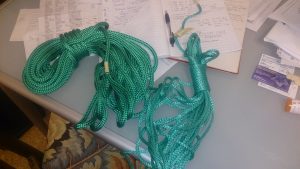
Making halyards is a stay-in-someplace-warm-and-splice-ropes job. I’ll be making my first dyneema soft shackles. My friend, Brion Toss is trying to convince the world that all metal shackles should be discarded and replaced by soft dyneema shackles. I’m quite willing to replace shackles on the deck of the boat with soft dyneema shackles, but all out-of-sight anchor shackles are not out of mind but instead block everything else out of mind until I build a much stronger level of trust.
 Coming from Amazon in the next few days are our new torque wrench, lithium ion batteries for the CO detector, a new high-end can opener, as we use many more cans while cruising than we do ashore, and a $700 replacement solid-state drive for my MacBook.
Coming from Amazon in the next few days are our new torque wrench, lithium ion batteries for the CO detector, a new high-end can opener, as we use many more cans while cruising than we do ashore, and a $700 replacement solid-state drive for my MacBook.

Before we leave, I will buy three new burners for the very money-hungry Taylor’s stove. This time we’ll buy one of them from Switzerland and see if that one is any better.
[15-DEC-2019 – We eventually tracked all of the stove problems to using the wrong fuel. One MUST use 1-k Kerosene. Nothing else will work. Marine stores carry it, as do most home improvement stores like Home Depot and Lowes.]
I’d also like to replace our auto helm and radar. Both time and money are limiting factors, as I did not install everything I bought last year. Top on the list of uninstalled items is the mainsheet track and car. While the track is fine, Ronstan no longer makes cars for it. And, the current car has been spewing broken parts for the last year.
Thank you for staying with me through this long soliloquy. It’s good to be back in the Pacific Northwest, it’s good to be back aboard CaroBabbo, and it’s wonderful to continue my life with Jennifer.
No blog entry is complete without talking about Hilary.
Hilary is doing well at a facility in Atlanta. She’s no longer on antidepressants† and seems to find the people with whom she lives and her life in general to be full of the joy that various Hilarys along the dementia trail have found, and which made Hilary the favorite of everyone in our life.
When we were at the Seattle boat show we met the numerous people we’ve come to know and enjoy in the boating community: some are friends, some are vendors. Some of them are from the Seattle area, and some we know from far away. It did, but shouldn’t have surprised us that everyone asked about Hilary.
07-FEB-2018 Regarding the starter relay: I visited Norm at MER yesterday. He told me that whenever the distance between the starter button and the starter is more than 10 feet (3M) MER installs a relay.
*Sam Club has also left Alaska.
†We are wrong about this. Hilary is still on anti-depressants.

